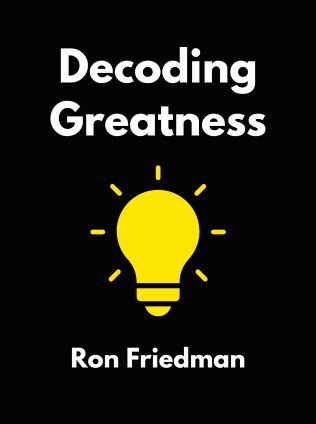
Decoding Greatness
How the Best in the World Reverse Engineer Success
By Ron Friedman
Published 06/2021
About the Author
Ron Friedman, Ph.D., is an award-winning social psychologist who has served on the faculty of the University of Rochester, Nazareth College, and Hobart and William Smith Colleges. He has consulted for political leaders, nonprofits, and many of the world’s most recognized brands. Friedman's research has been featured on NPR and in major newspapers. He is the founder of ignite80, a learning and development company that translates research in neuroscience, human physiology, and behavioral economics into practical strategies that help working professionals become healthier, happier, and more productive.
Main Idea
In Decoding Greatness: How the Best in the World Reverse Engineer Success, Ron Friedman reveals a powerful third path to success: reverse engineering. This method involves looking beyond the surface to uncover hidden structures that can be emulated. Through examples of top performers and groundbreaking research on pattern recognition, skill acquisition, and creative genius, Friedman demonstrates how anyone can harness this vital skill to achieve greatness.
Table of Contents
- Introduction: The Power of Reverse Engineering
- The Art of Unlocking Hidden Patterns
- How to Reverse Engineer a Billion-Dollar Franchise
- Algorithmic Thinking
- The Curse of Creativity
- Closing the Vision-Ability Gap
- The Scoreboard Principle
- How to Take the Risk Out of Risk Taking
- Practicing in Three Dimensions
- How to Talk to Experts
Introduction: The Power of Reverse Engineering
Friedman begins by explaining the concept of reverse engineering, which involves deconstructing successful models to understand their underlying structures. This approach has been used by innovators across various fields, including technology, art, and business. By analyzing how top performers achieve their success, individuals can apply similar strategies to their own pursuits.
"To reverse engineer is to look beyond what is evident on the surface and find a hidden structure." — Ron Friedman
Reverse engineering allows individuals to break down complex systems into understandable components, offering insights into how something works and how it can be replicated or improved. This method has been instrumental in various technological advancements and creative breakthroughs. For instance, Michael Dell dismantled an Apple II to understand its assembly, leading to the founding of Dell Computers. Similarly, Compaq reverse engineered an IBM personal computer, which paved the way for portable computers.
The Art of Unlocking Hidden Patterns
Friedman highlights the importance of pattern recognition in achieving greatness. He discusses how many renowned artists, writers, and entrepreneurs have developed their skills by copying and analyzing the works of their predecessors. This process of imitation allows them to understand the decision-making patterns that lead to success.
- Claude Monet and Pablo Picasso copied works of other artists to develop their skills.
- Successful entrepreneurs like Jeff Bezos excel at recognizing patterns in business models.
"What makes copywork so effective is that it forces an artist or writer to do more than simply recall content." — Ron Friedman
Copywork enables individuals to immerse themselves in the creative process of others, providing a deeper understanding of the techniques and choices that contribute to a masterpiece. This method is not limited to the arts but is also prevalent in business and technology. For example, Jeff Bezos and other successful entrepreneurs excel at recognizing patterns in business models, allowing them to replicate and innovate effectively.
How to Reverse Engineer a Billion-Dollar Franchise
Friedman illustrates how reverse engineering has been pivotal for entrepreneurs like Michael Dell and Steve Ells. By deconstructing existing successful models, they were able to innovate and create billion-dollar franchises.
Sign up for FREE and get access to 1,400+ books summaries.
You May Also Like
The Subtle Art of Not Giving a F*ck
A Counterintuitive Approach to Living a Good Life
By Mark MansonRich Dad Poor Dad
What the Rich Teach Their Kids About Money - That the Poor and Middle Class Do Not!
By Robert T. KiyosakiHow To Win Friends and Influence People
The All-Time Classic Manual Of People Skills
By Dale CarnegieFreakonomics
A Rogue Economist Explores the Hidden Side of Everything
By Steven D. Levitt and Stephen J. Dubner



















